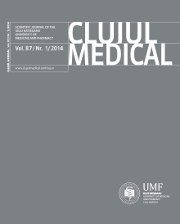Increased Chemerin and Decreased Omentin-1 Levels in Morbidly Obese Patients are Correlated with Insulin Resistance, Oxidative Stress and Chronic Inflammation
DOI:
https://doi.org/10.15386/cjm.2014.8872.871.afc1Keywords:
morbid obesity, adipokines, oxidative stress, chronic inflammationAbstract
Background and aim. Morbid obesity represents a proinflammatory and pro-oxidative state associated with dysregulation of adipokines. We aimed to evaluate the circulating levels of chemerin and omentin-1 in morbidly obese (MO) patients and to investigate the relationship between these two adipokines and between each of them and anthropometric, metabolic, oxidative stress and chronic inflammatory parameters.
Material and methods. 32 MO patients and 20 controls were investigated in this study. Anthropometric, metabolism parameters, inflammatory markers, oxidative stress indicators as well as chemerin and omentin-1 were measured.
Results. Serum levels of chemerin were increased while omentin-1 levels were decreased in MO patients when compared with controls. Chemerin correlated positively with insulin, HOMA-IR, LDL cholesterol and negatively with total antioxidant response. Omentin-1 correlated negatively with tumor necrosis factor alpha and total cholesterol. In a multiple linear stepwise regression analysis we learnt that only HOMA-IR (β=0.70, p<0.001), total cholesterol (β=0.42, p<0.001) and triglycerides (β=0.31, p<0.05) remained significantly associated with chemerin changes. Using the same analysis we noticed that total cholesterol (β=-0.71, p<0.001), fasting glucose (β=-0.40, p<0.05) and body mass index (BMI) (β=-0.38, p<0.05) were considered to be significant predictors for omentin-1 changes.
Conclusions. Chemerin and omentin-1 synthesis was dysregulated in MO patients. Chemerin might play a role in insulin resistance and oxidative stress. Chemerin changes seemed to be predicted mainly by insulin resistance. Omentin-1 levels were inversely associated with chronic inflammation and dyslipidemia while the main modulating factors seemed to be dyslipidemia, hyperglycemia and BMI.
Downloads
Published
How to Cite
Issue
Section
License
The authors are required to transfer the copyright of the published paper to the journal. This is done by agreeing to sign the Copyright Assignment Form. Whenever the case, authors are also required to send permissions to reproduce material (such as illustrations) from the copyright holder.

The papers published in the journal are licensed under a Creative Commons Attribution-NonCommercial-NoDerivatives 4.0 International License.

